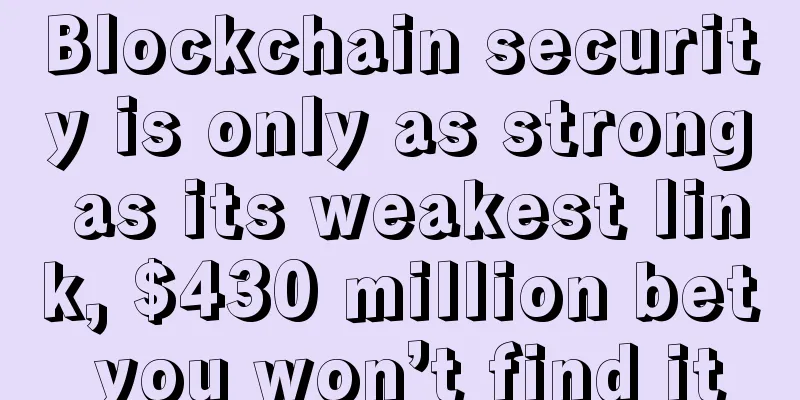Blockchain security is only as strong as its weakest link, $430 million bet you won’t find it

|
The blockchain shockwaves are dominating the news, grabbing attention, and pushing the financial crisis up and down. Venture capitalists are salivating over blockchain, with their collective investments in the space exceeding the $1.2 billion mark. Large financial institutions are also cheering the latest blockchain technology - and starting to patent everything related to it, trying to get ahead of being chained to the chain itself (like the suffragettes in 1920) or being patented by competitors.
With an estimated $20 billion in infrastructure cost savings per year, it’s easy to see why so many people are drawn to exploring this technology. The opportunities (and threats) presented by this technology are clear. New ideas and new proofs of concept are being developed every day – so many that it’s often difficult to keep track of all the ideas being developed. But if the underlying technology is flawed, none of these ideas or proofs of concept can be realized. How secure is this underlying blockchain technology?First of all, I am not a crypto geek. Instead, I am a blockchain entrepreneur working on a smart ownership and distribution platform for film and video producers that protects them from theft and piracy. So, I wanted to explain the security of blockchain from a business perspective, rather than convincing anyone through math, computer science and cryptography talks. The first business proof is the first and most complete use case of blockchain technology - Bitcoin. Although Bitcoin itself has a somewhat tarnished reputation, it has proven itself to have benefits as a bulwark of defense and security since its launch in 2009. Bitcoin uses advanced cryptographic techniques to protect itself and generate new bitcoins, and the cryptocurrency relies on decentralization and advanced mathematics to protect its security. Transactions are verified and confirmed by multiple independent computers (nodes) on an interconnected global network, and there is simply no weakness that can be attacked. Similarly, the Bitcoin protocol uses the most advanced encryption technology currently available - SHA-256. This security sounds impressive in theory, but the best way to prove the security of the technology is through a bounty offered to anyone who can successfully break the underlying technology. The existence of this bounty in Bitcoin is not widely publicized, however; it was only hinted at in some excellent analytical work in 2010, and it still exists today. In 2010, Sergio Lerner published a blog post in which he believed that Bitcoin creator Satoshi Nakamoto owned approximately 1 million Bitcoins. Currently, because all transactions and movements on the Bitcoin blockchain are permanent and transparent, all transfer information of any Bitcoin can be viewed by anyone through the network. These so-called 'Satoshi Bitcoins' have not been moved since the day they were 'mined' 6 years ago. In other words, since the birth of Bitcoin, the founder of Bitcoin himself has left 1 million Bitcoins intact, which is worth about $430 million at the current exchange rate. These untouched Bitcoins are a testament to Satoshi Nakamoto’s belief in the security of Bitcoin. These Bitcoins represent a massive and tempting $430 million reward to the world’s brightest minds to try to attack the Bitcoin blockchain and steal these coins. To date, these coins remain untouched. There is no doubt that people have tried and will continue to attack Bitcoin, but, as mentioned earlier, the Bitcoin blockchain uses the SHA-256 encryption algorithm. To put this into context, a credit card number, for example, consists of 16 digits - there are 1000 quintillion different ways to combine them, which is a 1 followed by 15 0s. Using SHA-256, the probability that someone will guess the correct private key combination is estimated to be 1 in 115 quattuorvigintillions, or 1 in 77 0s! In other words, there are more combinations of private keys available on the Bitcoin blockchain than there are grains of sand on any beach in the world. In fact, one cryptographer once estimated that it would take all supercomputers in the Bitcoin network 650 million years to replicate all the private keys. So if SHA-256 is so secure, why do we often hear about Bitcoin and other cryptocurrencies being stolen in the media? Now, for those of you who are new to Bitcoin or other cryptocurrencies, when you want to access your cryptocurrency, you need to 'unlock' your cryptocurrency using your personal 'private key' - this 'private key' is a randomly generated 52-character cryptographic address made up of random letters and numbers that only you know. Once you unlock it, you can send your Bitcoin to any address you want. So it's pretty simple; aim for the private key. At this point, hackers have rogue software that can scrape the internet for Bitcoin private keys - leaving naive wallets open to be stolen - and unfortunately, many of these wallets have been discovered by hackers. All in all, Bitcoin has proven itself to be a secure commercial use case for blockchain technology - our own human fragility is the real weakest link of blockchain. Perhaps this is the real reason why Satoshi Nakamoto's identity remains elusive. |
>>: Not Bitcoin, but Blockchain: Russian government tests blockchain file management system
Recommend
Does having a widow's peak mean a bad marriage?
Does having a widow’s peak mean a bad marriage? M...
The initiator of the Spanish pyramid scheme has been arrested
The founder of pyramid scheme 'unete' has...
A complete guide to women's palm reading. Here we will teach you how to read palms
(1) Jupiter Hill The Jupiter Hill represents powe...
Zhuge's Divination 25 - The worst fortune Gou Shangjiu
Since ancient times, there has been no shortage o...
Three Japanese public companies launch new mining plans, cryptocurrency exchanges and token funds
According to Bitcoin.com, three Japanese listed c...
Do you have a peach blossom mole that will bring you romantic luck?
If you want to know when you will have good luck ...
How to tell the face of a bad man
A person's good and evil will be reflected in...
People who care about social current affairs
For us, paying attention to this society and not ...
What is the fate of a man with white eyes? What is the character of a man with white eyes?
1. Men with white eyes All the places with white ...
New report: Most decentralized exchanges are not secure
The survey found that only two DEXs received high...
Introduction to moles that are unfavorable to wealth. Where are the moles that are unfavorable to wealth?
An introduction to moles that are unfavorable to ...
Revealing the secrets of what kind of men have evil intentions
We often say that we should not associate with pe...
Existence is reasonable, an interpretation of the necessity of competing coins for the development of Bitcoin
I believe many Bitcoin enthusiasts will wonder wh...
Blockchain: A gold mine similar to the Internet in 1994
2015 is regarded as the first year of blockchain ...
Are men with many nasolabial lines good for their wives?
When it comes to some facial features, many peopl...









